- Clone
- SA222C5 (See other available formats)
- Regulatory Status
- RUO
- Other Names
- G-Protein coupled receptor 49 (GPR49), G-Protein coupled receptor 67 (GPR67), FEX, HG38
- Isotype
- Mouse IgG2a, κ
- Ave. Rating
- Submit a Review
- Product Citations
- publications
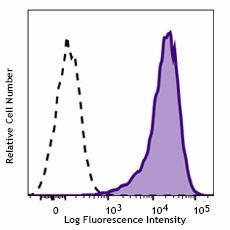
-

Human LGR5 transfected Ba/F3 cells were stained with anti-human LGR5 (clone SA222C5) APC (filled histogram) or mouse IgG2a, κ APC isotype control (open histogram).
| Cat # | Size | Price | Quantity Check Availability | Save | ||
|---|---|---|---|---|---|---|
| 373805 | 25 tests | 157€ | ||||
| 373806 | 100 tests | 328€ | ||||
LGR5, also known as GPR49, is a 100 KD protein. It is a member of GPCR class A orphan receptor proteins which binds R-spondin and does not activate through heterotrimeric G protein like other GPCR. It triggers the Wnt signaling pathway downstream. LGR5 is expressed across a diverse range of tissue such as in the muscle, placenta, spinal cord and brain and particularly as a biomarker of adult stem cells in certain tissues.
Product DetailsProduct Details
- Verified Reactivity
- Human
- Antibody Type
- Monoclonal
- Host Species
- Mouse
- Immunogen
- Human LGR5 transfectant cells
- Formulation
- Phosphate-buffered solution, pH 7.2, containing 0.09% sodium azide and BSA (origin USA)
- Preparation
- The antibody was purified by affinity chromatography and conjugated with APC under optimal conditions.
- Concentration
- Lot-specific (to obtain lot-specific concentration and expiration, please enter the lot number in our Certificate of Analysis online tool.)
- Storage & Handling
- The antibody solution should be stored undiluted between 2°C and 8°C, and protected from prolonged exposure to light. Do not freeze.
- Application
-
FC - Quality tested
- Recommended Usage
-
Each lot of this antibody is quality control tested by immunofluorescent staining with flow cytometric analysis. For flow cytometric staining, the suggested use of this reagent is 5 µL per million cells in 100 µL staining volume or 5 µL per 100 µL of whole blood. It is recommended that the reagent be titrated for optimal performance for each application.
- Excitation Laser
-
Red Laser (633 nm)
- RRID
-
AB_2904406 (BioLegend Cat. No. 373805)
AB_2904406 (BioLegend Cat. No. 373806)
Antigen Details
- Structure
- G-protein coupled receptor (GPCR) superfamily
- Distribution
-
Muscle, placenta, spinal cord, brain and particularly as a biomarker of adult stem cells in certain tissues.
- Function
- Triggers Wnt signaling pathway.
- Interaction
- Wnt pathway
- Ligand/Receptor
- R-spondins (RSpo 1,2,3, and 4)
- Biology Area
- Immunology
- Antigen References
-
1. Hsu Sy, et al. 1998. Mol. Endocrinol. 12:1830.
2. Barker N, et al. 2007. Nature. 449:1003.
3. Morita H, et al. 2004. Mol. Cell. Biol. 24(22):9736.
4. Arioka Y, et al. 2017. Stem Cell Res. 20:1.
5. Wang B, et al. 2016. Plos. One. 11:e0168904.
6. Garcia MI, et al. 2009. Dev. Biol. 331:58. - Gene ID
- 8549 View all products for this Gene ID
- UniProt
- View information about LGR5 on UniProt.org
Related Pages & Pathways
Pages
Related FAQs
Other Formats
View All LGR5 (GPR49) Reagents Request Custom Conjugation| Description | Clone | Applications |
|---|---|---|
| Purified anti-human LGR5 (GPR49) | SA222C5 | FC |
| PE anti-human LGR5 (GPR49) | SA222C5 | FC |
| APC anti-human LGR5 (GPR49) | SA222C5 | FC |
| PE/Dazzle™ 594 anti-human LGR5 (GPR49) | SA222C5 | FC |
| PE/Cyanine7 anti-human LGR5 (GPR49) | SA222C5 | FC |
Customers Also Purchased
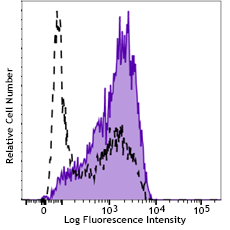
Compare Data Across All Formats
This data display is provided for general comparisons between formats.
Your actual data may vary due to variations in samples, target cells, instruments and their settings, staining conditions, and other factors.
If you need assistance with selecting the best format contact our expert technical support team.
-
Purified anti-human LGR5 (GPR49)
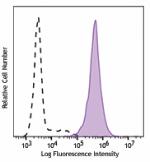
BaF3 cells transfected with human LGR5 were stained with pur... -
PE anti-human LGR5 (GPR49)
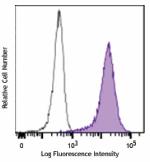
BaF3 cells transfected with human LGR5 were stained with ant... -
APC anti-human LGR5 (GPR49)
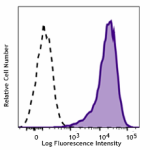
Human LGR5 transfected Ba/F3 cells were stained with anti-hu... -
PE/Dazzle™ 594 anti-human LGR5 (GPR49)
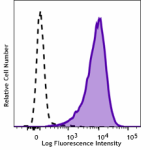
Human LGR5 transfected Ba/F3 cells were stained with anti-hu... -
PE/Cyanine7 anti-human LGR5 (GPR49)
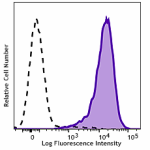
Human LGR5 transfected Ba/F3 cells were stained with anti-hu...
 Login / Register
Login / Register 















Follow Us